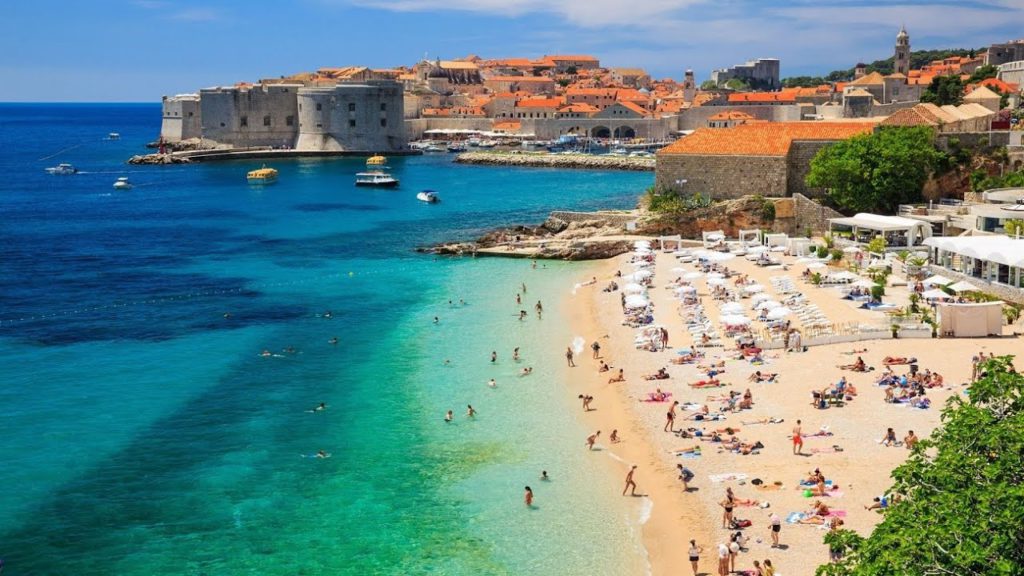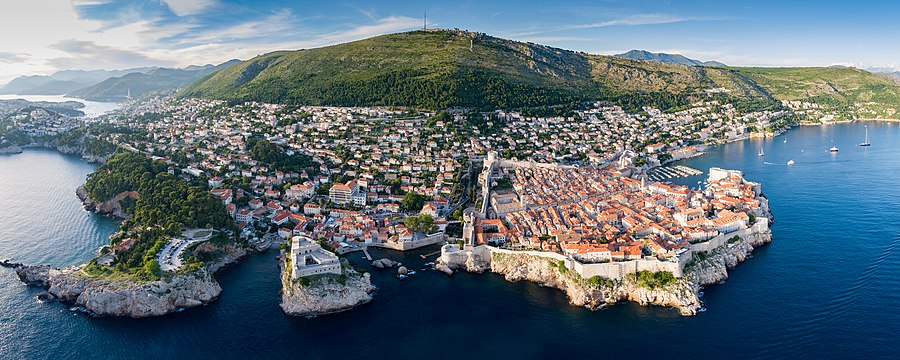A Kaleidoscope of Adriatic Wonders Awaits. Wander through Centuries of History, Embrace the Coastal Serenity, and Immerse Yourself in Dubrovnik’s Cultural Tapestry. Get Ready to Embark on a Remarkable Expedition, Where Every Corner Tells a Story of Beauty, Resilience, and Captivation
Where is Dubrovnik located?
Dubrovnik, formerly Ragusa, is a city on the Adriatic Sea coast in Croatia’s extreme south, located at the terminus of the Dubrovnik Isthmus. It is known as the “Pearl of the Adriatic” because it is the most picturesque city on the Dalmatian coast.
It is a seaport and the administrative centre of the Dubrovnik-Neretva County, as well as one of the most popular tourist destinations in the Mediterranean. It has a total population of 42,615 people (2011 census). Dubrovnik was added to the UNESCO list of World Heritage Sites in 1979 for its outstanding mediaeval architecture and fortified old town.
The city’s prosperity is based on maritime trade. It was the only eastern Adriatic city-state to rival Venice in the Middle Ages, as the Republic of Ragusa. The city achieved a remarkable level of development, particularly during the fifteenth and sixteenth centuries, thanks to wealth and skilled diplomacy. It received protection as a tributary of the Ottoman Sultan, which preserved its liberty and position as a major centre of trade between the Ottoman Empire and Europe. Ragusa was a centre of Croatian language, literature, and scientific development, with many notable poets, playwrights, painters, mathematicians, physicists, and scholars residing there.
How did Dubrovnik get its name?

Dubrovnik’s current name is derived from the Croatian word Dubrava, which means oak woods, as oak trees once surrounded the city. The Latin name Ragusa – Rausa, which was in use until the 15th century, was derived from the rock (lat. Lausa – meaning rock) on which the first settlement was established.
Who said Dubrovnik as the Pearl of the Adriatic?
Tourism made its first appearance during Austria’s reign. Lord Byron is said to have called Dubrovnik “the Pearl of the Adriatic” during his Grand Tour. Later, famous authors such as Bernard Shaw and Agatha Christie were captivated by the immaculately preserved baroque oasis.
Why is Dubrovnik called the Pearl of the Adriatic?
Due to the beautiful Gothic, Renaissance, and Baroque architectural style of its monuments, palaces, and churches, as well as the natural outstanding Mediterranean scenery and temperate climate all year, Dubrovnik, or Ragusa in Italian, is also known as the Pearl of the Adriatic.
How does it emerge as top tourist destination of the Mediterranean?
When a devastating earthquake struck in 1667, the entire city was almost destroyed. During the Croatian War of Independence in 1991, Dubrovnik was besieged for seven months by the Yugoslav People’s Army and suffered significant shelling damage. It re-emerged as one of the Mediterranean’s top tourist destinations and a popular filming location after undergoing restoration and repair works in the 1990s and early 2000s.
Striking feature of Dubrovnik

The walls that run 1.2 miles (2 kilometers) around Dubrovnik are a striking feature. They reach a height of about 80 feet (25 meters) and are 13 to 20 feet (four to six meters) thick on the landward side but much thinner on the seaward side. The turrets and towers that were built to protect the vulnerable city are now one of the most spectacular sights on the Adriatic.
Why is Dubrovnik famous?
It is well-known for its rich history and culture, as well as its stunning architecture and scenic landscapes. The city’s Old Town is a UNESCO World Heritage Site and home to historic landmarks such as the Dubrovnik Walls and the Rector’s Palace.
What is unique about Dubrovnik?
The Pearl of the Adriatic is a tourist magnet, and rightly so, with so many unique things to do in Dubrovnik! The dazzling city is a stunning combination of an ancient town, turquoise waters, baroque architecture, and terracotta rooftops.
King’s Landing, one of the most prominent cities in the world-famous television series Game of Thrones, was primarily filmed in Dubrovnik. Because of the inherent beauty of the city’s Old Town, the production did not need to construct scenery or sets, nor did it need to rely on obvious special effects. However, Game of Thrones is not the only mega-franchise filming in the city. Star Wars: The Last Jedi scenes were also shot in Dubrovnik. Casino planet Canto Bight took place in parts of the Old Town.
Festivals of Dubrovnik
Residents of Dubrovnik enjoy a good time just as much as anyone else, and they have a lively admiration for music, dancing, and celebrating their beautiful city. Here are some of the best festivals and events that take place in Dubrovnik each year.
New Year’s Eve
Dubrovnik is one of the best places in the world to ring in the New Year. Dubrovnik fills Stradun and the side streets, transforming the walled city into one big outdoor party. Croatian pop stars, celebrities, musicians, and entertainers provide musical accompaniment, while stalls selling fritters, dried figs, carob almonds, and champagne keep the revellers fed and watered. This is not to be missed.
Feast of St Blaise
St Blaise is Dubrovnik’s patron saint, with several dozen statues of him looking down on the city. On February 3, the entire city of Dubrovnik comes out to commemorate his feast day. Villagers from the province flock to Dubrovnik to celebrate their culture through colourful costumes and traditional dance
Carnival
Everyone starts preparing for Carnival as soon as the Feast of St Blaise is over. The celebrations culminate three days before Ash Wednesday, when masked and costumed groups roam the old streets singing and dancing. Masked balls are frequently held in private homes, but there is always plenty of action on Stradun.
Dubrovnik FestiWine brings together over 100 regional vintners to showcase their products to professionals, locals, and visitors.
Music lovers will enjoy the new Dubrovnik Musical Spring, which features a full cycle of traditional music concerts by the Dubrovnik Symphony Orchestra.
Summer festivals
Every summer, the Dubrovnik Summer Festival keeps the Old Town young. Concerts of various types are held nearly every night in venues throughout town, and every venue with a stage hosts a play or two. The most prestigious is the conventional Hamlet production at Fort Lovrijenac. Goran Visnjic, of “ER” fame, played the brooding prince there.
Major attractions at Dubrovnik
The beautiful city of Dubrovnik, dubbed the “Pearl of the Adriatic,” offers a wealth of intriguing attractions to explore. Dubrovnik is known for its spectacular seafront location on the Dalmatian Coast, as well as its evocative and historic Old Town district. It is home to Croatia’s artistic and intellectual elite, and it hosts a variety of cultural activities and festivals.
The best parts of a trip include exploring its charming old streets and alleys while taking in top sights like its magnificent cathedral and treasury, the long Stradun pedestrian walkway, and its numerous fine old palaces and fortifications.
Dubrovnik is popular for its stunning seafront location on the Dalmatian Coast, as well as its evocative and historic Old Town district. It is home to Croatia’s artistic and intellectual elite and offer multiple cultural opportunities.
The Old City Walls
Dubrovnik’s old city walls are one of its most well-known features, now more than ever thanks to their appearance in the hit TV series Game of Thrones. These formidable walls—as high as six meters in places and up to six meters thick—built in the 10th century and modified in the 13th and 14th centuries—provided a solid defense against invaders. Dubrovnik’s city walls, which are nearly two kilometers long, are a great place for a casual stroll and provide numerous excellent views of the Adriatic and the old city centre.
Walk through Stradun
The spectacular Stradun, also known as Placa in Dubrovnik, is a place where locals and visitors alike congregate day and night to watch the world go by. The Stradun, without a doubt one of Europe’s most scenic pedestrian thoroughfares, possesses many cafés and restaurants and is a good spot to do some shopping or rest weary feet after a day of touring Dubrovnik.
Dubrovnik Cathedral and Treasury
Beautiful Dubrovnik Cathedral-also known as the Assumption Cathedral-stands on the site of an older cathedral dating from the sixth century that was destroyed by earthquakes. The Cathedral Treasury is a must-see for its many important relics, the most famous of which is a portion of the cross on which Jesus is thought to have been crucified. The head, leg, and arm of St. Blaise, the city’s patron saint, are also famous relics.
The City Gates
Dubrovnik’s famous Pile Gate has served as the main entrance for centuries and remains the most interesting access point to this fantastic old city. The 14th-century Ploce Gate, located just behind the Asimov Tower, is also worth seeing.
The Loggia Square
Loggia Square in Dubrovnik has long been a popular meeting place for locals and visitors alike. This former market square, located in the northeast section of the old city centre, contains some of Dubrovnik’s most famous buildings and public monuments.
Fort Lovrijenac
Fort Lovrijenac, also known as St. Lawrence Fortress, has long been one of Croatia’s most important fortresses, dubbed “Dubrovnik’s Gibraltar” due to its location on a rocky promontory just outside the city’s western wall.
The Onofrio Fountain and St. Saviour Church
Dubrovnik’s famous Large Fountain of Onofrio, built between 1438 and 1444, is probably the most well-known of the city’s many historic monuments. This landmark structure, a short walk from the Pile Gate, is slightly smaller today than it was originally due to damage caused by the 1667 earthquake. The fountain was a key component of the city’s original water supply system (also designed by Onofrio de la Cava), which brought water from the Dubrovacka river.
Minceta Tower
The impressive Minceta Tower (Tvrdava Minceta), located on the city wall system, is well worth seeing. The tower, which was built in 1319 and reinforced in 1461, casts an imposing shadow on the old town below. The tower also served as a major backdrop for a famous scene in Game of Thrones, in which Daenerys goes in search of her stolen dragons.
Cable Car in Dubrovnik
Another enjoyable activity for visitors to Dubrovnik is to take the cable car to the hills. The Dubrovnik Cable Car takes visitors high above the Old Town, up Srd Hill, with views that improve as one climb (on clear days, it’s said one can see for 50 kilometers). The trip takes less than ten minutes.
The Dominican Monastery
The Dominican Monastery in Dubrovnik, built in the early 1300s, was so large that it required the relocation of parts of the city walls. The monastery was severely damaged in the 1667 earthquake and was completely rebuilt in its current form.
The Rector’s Palace and Cultural Historical Museum
This magnificent old palace, a beautiful mix of late Gothic and early Renaissance styles, was severely damaged by a gunpowder detonation not long after its completion, later by a fire, and then again in 1667 when an earthquake struck. This well-preserved building is now a joy to explore, especially its pleasant central courtyard.
Banje Beach
Dubrovnik has more to offer than just sightseeing. Banje Beach, located in this historic city, is widely regarded as one of the best beaches in Croatia. It’s a wonderful place to relax and splash your feet, or go for a swim, and it’s only a short walk from the historic Old Town.
The Museum of Modern Art Dubrovnik
The Museum of Modern Art Dubrovnik (MOMAD), which opened in 1945, is a must-see for art lovers. The building itself—once home to one of the city’s leading families—is quite stunning, housing an impressive collection of over 3,000 artworks by leading Croatian and international artists, as well as works by local artists.
